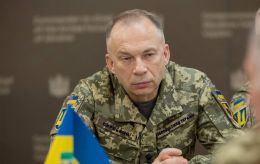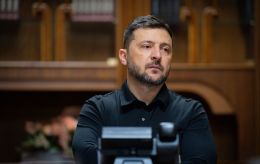Ambassador explains how US would monitor assistance to Ukraine
 Photo: US Ambassador to Ukraine Bridget Brink (Vitalii Nosach, RBC-Ukraine)
Photo: US Ambassador to Ukraine Bridget Brink (Vitalii Nosach, RBC-Ukraine)
During a roundtable discussion with the Deputy Administrator of USAID, Isobel Coleman, US Ambassador to Ukraine Bridget Brink stated that the US position since the beginning had been not to enable or encourage using of its weapons in Russia, outside of Ukrainian territory.
During a meeting with journalists, Brink was asked about the conditions of assistance from the US to Ukraine and who controls its use.
"I'm not able to talk specifically on that (conditions - ed.) at this point, but I can tell you that is also something that from our own Congress, there's a lot of interest to make sure [...] that as we are giving this assistance, it is in concert with Ukraine's effort also to take steps that are transforming the country," she said
"Every piece of the assistance has various kinds of oversight, and I can also defer to the Deputy Administrator on pieces of it that her agency specifically is responsible for. But first of all, the security assistance, and that's the biggest part of the Ukraine aid, of the supplemental, that is actually not money, but it's weapons," the ambassador explained.
According to Brink, the United States closely collaborates with the Ministry of Defense of Ukraine and other security services.
"It is a challenge because you're in the middle of a war, sometimes in terms of how do you account for battlefield losses. So we've had to come up with some alternative methods of oversight that we have worked with our government back in D.C., with your government, to be able to track even weapons in that context to the best extent of our ability. That's a very significant part of our oversight," Brink said.
She also noted that a separate part is direct financial support from the US to Ukraine. The third part includes humanitarian and economic assistance, administered by the United States Agency for International Development (USAID).
Brink explained that other parts of the assistance are administered by various government agencies, including the US State Department. The ambassador mentioned that procedures have been established regarding the third part of the assistance, as it closely resembles all types of aid that the United States provides worldwide.
"Usually, it is done with a program implementer. And then that implementer has a bunch of things that it has to do and account for to us at the embassy, and then also, as we do, to Congress," the ambassador told journalists.
A third of the American diplomatic team is responsible for overseeing all US assistance, but besides this, there is the OIG platform - it is located at the embassy but operates independently of the ambassador. Its task and duty are to monitor what American diplomats are doing and to monitor what the Ukrainian government is doing. This structure exists not only at the embassy but also in Washington.
What is OIG
OIG stands for the Office of Inspector General, which operates within USAID, the State Department, and the Department of Defense of the United States. It comprises 400 individuals. They already have over 150 reports at their disposal, which are either completed or in the process of execution.
"So it's a very serious oversight effort and one which we support as part of our efforts to properly use US taxpayer money. And about conditions. So we know there are some conditions for us to use this (funds - ed.)," Brink explained.
She couldn't disclose the details of these reports, but she noted that from the US side, there is an interest in ensuring that, by providing this assistance, the States are acting in line with Ukraine's efforts to transform the country.
At the same time, Isabel Coleman noted that financial support for Ukraine is one of the toughest aspects to go through this additional funding. Therefore, much attention is focused on it. According to her, funds for inspection and accounting have also been included in US assistance to Ukraine.
"So that scrutiny will continue, and we're well aware of it. We are taking every measure to make sure that the money is being used as it should be used. And the direct budget support in this supplemental is able to go to healthcare workers, the education sector teachers, and also first responders. So it does provide significant resources for the government to pay those expenses, freeing up money for the government to use its own resources for other things," Coleman said.
US aid for Ukraine
At the end of April, the United States approved assistance to Ukraine in the amount of over $60 billion. However, this raised questions about how it would be utilized.

